

Exploring our past to sort out myth from reality
Share this Page on
Facebook or Twitter

These are the voyages of the TimeShip Anachron.
Our Mission: To boldly explore the past, dispelling
mythinformation and mythconceptions
of American History along the way.
 Visit us on Facebook
Visit us on Facebook
Meet MythAmerica Series

Pt 1 Pt 2 Pt 3 Pt 4 Pt 5 Pt 6 Pt 7 Pt 8 Pt 9
Terrorism on American Soil, Part 3
Into the Maelstrom
To recap the events of the Tulsa Holocaust as they stood at the end of Part 3 in this series:
It’s May 31, 1921, in Tulsa, Oklahoma. Dick Rowland, a 19 year old black shoeshine boy, is in police custody at the Tulsa Courthouse jail as the result of vague charges related to some sort of encounter in an elevator with a 17 year old white female elevator operator. Given the frequency in recent times across the US and in Oklahoma of incidents of lynching of negroes by white mobs, especially if the accusation has to do with a sexual encounter of ANY kind with a white female, the local black community called Greenwood in north Tulsa is deeply concerned about the young man’s safety. Rumors of plans for a lynching among white Tulsans have raced across “white Tulsa” and led to a large white crowd gathering for several hours in front of the Tulsa County Courthouse (shown here in 1941):
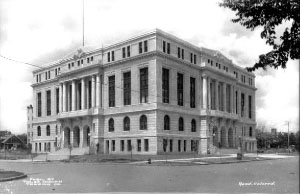
According to records retrieved by later researchers…
By sunset — which came at 7:34 p.m. that evening — observers estimated that the crowd had grown into the hundreds. Not long afterwards, cries of “Let us have the nigger” could be heard echoing off of the walls of the massive stone courthouse. [SOURCE: unless otherwise noted, all quotations in this entry are from this source.].
Around 9:00 PM, a contingent of about 25 armed blacks from Greenwood show up at the courthouse concerned that the police will be unable to protect Rowland from growing pressure by the crowd.
Their purpose, they announced to the no doubt stunned authorities, was to offer their services toward the defense of the jail — an offer that was immediately declined. Assured that Dick Rowland was safe, the men then returned to their automobiles, and drove back to Greenwood.
… The visit of the African American veterans had an electrifying effect, however, on the white mob, now estimated to be more than one thousand strong. Denied Rowland by Sheriff McCullough, it had been clear for some time that this was not to be an uncomplicated repetition of the Belton affair. The visit of the black veterans had not at all been foreseen. Shocked, and then outraged, some members of the mob began to go home to fetch their guns.
As we left off the story last time, Scott Ellsworth, an official chronicler of the events (part of a blue-
With each passing minute, Tulsa was a city that was quickly spinning out of control.
Indeed, it was about to enter a maelstrom. A fiery maelstrom.
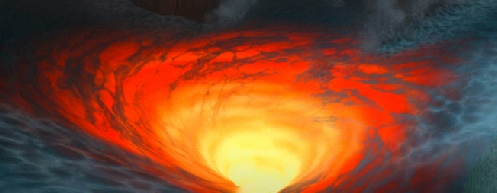
So…to continue the story:
By 9:30 p.m., the white mob outside the courthouse had swollen to nearly two-
Police Chief John A. Gustafson later claimed that he tried to talk the lynch mob into dispersing. However, at no time that afternoon or evening did he order a substantial number of Tulsa policemen to appear, fully armed, at the courthouse. Gustafson, in his defense, would later claim that because there was a regular shift change that very day, that only thirty-
Two thousand people gathered in front of the courthouse late at night, some or many of them chanting that they wanted to put to death a 19 year old boy? And the Chief exits the scene?? (The county sheriff, Willard McCullough, was meanwhile inside with his men on the roof, guarding Rowland.)
In the city’s African American neighborhoods, meanwhile, tension continued to mount over the increasingly ugly situation down at the courthouse. Alerted to the potentially dangerous conditions, both school and church groups broke up their evening activities early, while parents and grandparents tried to reassure themselves that the trouble would quickly blow over. Down in Deep Greenwood, a large crowd of black men and women still kept their vigil outside of the offices of the Tulsa Star, awaiting word on the latest developments downtown.
…In the midst of all of this activity, rumors began to circulate, particularly with regards to what might or might not be happening down at the courthouse. Possibly spurred on by a false report that whites were storming the courthouse, moments after 10:00 p.m., a second contingent of armed African American men, perhaps seventy-
It would seem that a crowd of 2000 milling about in front of the courthouse at 10 PM at night, even if they weren’t “storming” the courthouse, might seem pretty threatening…
Then it happened. As the black men were leaving the courthouse for the second time, a white man approached a tall African American World War I veteran who was carrying an army-
Skipping forward for a moment… The smoke had barely settled on a completely destroyed community across the tracks not far from this scene at the courthouse, when a grand jury was convened—about a month after the event—to decide “what had caused” the holocaust. They concluded that the total responsibility for the entire affair lay with the negro men who had come to the courthouse armed. The armed white men who were filling the streets in front of the courthouse because they wanted to lynch a 19 year old young man incarcerated there had nothing to do with it. The armed white men who stormed the streets of Greenwood and torched hundreds upon hundreds of buildings occupied by and owned by totally innocent bystanders bore no responsibility. The armed white men who gunned down totally innocent bystanders on the streets of downtown Tulsa, and later in the homes and streets of Greenwood, bore no responsibility. No, it was “those negroes” who brought it all on themselves.
As the details of the events unfold in the rest of this series, see if this is the conclusion you would have come to based on the evidence. Over 75 years later, cooler heads in the Tulsa community considered “the facts” again, under an order from the Oklahoma government to establish a research committee to investigate the 1921 Riot. The blue-
While the first shot fired at the courthouse may have been unintentional, those that followed were not. Almost immediately, members of the white mob — and possibly some law enforcement officers — opened fire on the African American men, who returned volleys of their own. The initial gunplay lasted only a few seconds, but when it was over, an unknown number of people — perhaps as many as a dozen — both black and white, lay – dead or wounded.
Outnumbered more than twenty-
Dr. George H. Miller, a white physician who was working late that evening in his office at the Unity Building at 21 W. Fourth Street, rushed outside after hearing the gunshots, only to come upon a wounded black man, “shot and bleeding, writhing on the street,” surrounded by a group of angry whites. As Dr. Miller later told an interviewer:
“I went over to see if I could help him as a doctor, but the crowd was gathering around him and wouldn’t even let the driver of the ambulance which just arrived to even pick him up. I saw it was an impossible situation to control, that I could be of no help. The crowd was getting more and more belligerent. The Negro had been shot so many times in his chest, and men from the onlookers were slashing him with knives.”
Unable to help the dying man, Dr. Miller got into his car and drove home.
Do note that all evidence points to the fact that during none of the situation did the negroes move from the courthouse area to the neighboring white business areas to rampage, nor to white neighborhoods to threaten residents. From this point on, they were totally in a defensive position, fighting for their lives, and to protect their own families and property back in Greenwood.
A short while later, a second, deadlier, skirmish broke out at Second and Cincinnati. No longer directly involved with the fate of Dick Rowland, the beleaguered second contingent of African American men were now fighting for their own lives. Heavily outnumbered by the whites, and suffering some casualties along the way, most were apparently able, however, to make it safely across the Frisco railroad tracks, and into the more familiar environs of the African American community.
At the courthouse, the sudden and unexpected turn of events had a jolting effect on the would-
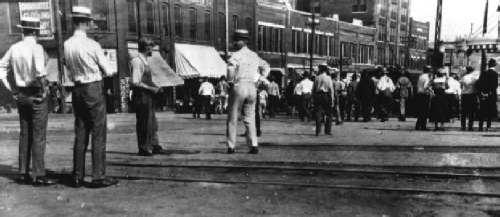
Following the outbreak of violence at the courthouse, crowds of angry whites took to the streets downtown…. groups of whites–including these at Main and Archer-
So there they were, a lynch mob liberally peppered with men with a bottle in one hand and a gun in the other. If you were part of the local law enforcement personnel, what do you think your priority would have been? One would think it would have been to disarm and disperse this crowd. But that wasn’t what happened.
Some were about to become, at least temporarily, officers of the law. Shortly after the fighting had broken out at the courthouse, a large number of whites – many of whom had only a little while earlier been members of the would-
BOYS? Yes, photos show that many of those whites involved in the direct violence seemed to be a lot younger than 21, such as this 2-
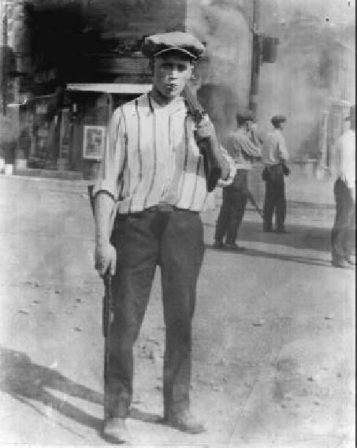
Some were provided with badges or ribbons indicating their new status. Many, it appears, also were given specific instructions.
According to Laurel G. Buck, a white bricklayer who was sworn-
So how did they “get a gun”?
Shortly thereafter, whites began breaking into downtown sporting goods stores, pawnshops, and hardware stores, stealing — or “borrowing” as some would later claim — guns and ammunition. Dick Bardon’s store on First Street was particularly hard hit as well as the J.W. MeGee Sporting Goods shop at 22 W. Second Street, even though it was located literally across the street from police headquarters. The owner later testified that a Tulsa police officer helped to dole out the guns that were taken from his store.
And did these armed men take their newly-
More bloodshed soon followed, as whites began gunning down any African Americans that they discovered downtown. William R. Holway, a white engineer, was watching a movie at the Rialto Theater when someone ran into the theater, shouting “Nigger fight, nigger fight”. As Holway later recalled:
“Everybody left that theater on high, you know. We went out the door and looked across the street, and there was Younkman’s drug store with those big pillars. There were two big pillars at the entrance, and we got over behind them. Just got there when a Negro ran south of the alley across the street, the minute his head showed outside, somebody shot him.”
“We stood there for about half-
Many such incidents of attacks on unarmed blacks were later described by white eye-
Not far away, at the Royal Theater – that was showing a movie called “One Man in a Million” that evening — a similar drama played itself out. Among the onlookers was a white teenager named William “Choc” Phillips, who later became a well-
“The mob action was set off when several [white] men chased a Negro man down the alley in back of the theater and out onto Fourth Street where he saw the stage door and dashed inside. Seeing the open door the Negro rushed in and hurried forward in the darkness hunting a place to hide.”
“Suddenly he was on the stage in front of the picture screen and blinded by the bright flickering light coming down from the operator’s booth in the balcony. After shielding his eyes for a moment he regained his vision enough to locate the steps leading from the stage down past the orchestra pit to the aisle just as the pursuing men rushed the stage. One of them saw the Negro and yelled, ‘there he is, heading for the aisle’. As he finished the sentence, a roaring blast from a shotgun dropped the Negro man by the end of the orchestra pit.”
Not everyone had forgotten about Dick Rowland.
Around midnight, a small crowd of whites gathered — once again — outside of the courthouse, yelling “Bring the rope” and “Get the nigger”. But they did not rush the building, and nothing happened.
Because the truth of the matter was that, by then, most of Tulsa’s rioting whites no longer particularly cared about Dick Rowland anymore. They now had much bigger things in mind.
And those things they had in mind seemed to have nothing to do with “fear” that the negroes would be a physical threat to “white Tulsa.” They didn’t seem concerned about “protecting” their neighborhoods from the “threat” of marauding blacks. This wasn’t a “black on white” riot! It was, as almost all the racial riots had been since Reconstruction, incidents of White Rage—against nothing in particular. Just the mere existence of negroes living in the community.
Well, no…most towns and cities were already totally segregated into negro ghettos that were on the margins of the white city limits. The issue was negroes HAVING a community that was anywhere near their White Space. As the message on the riot postcard in a previous blog entry put it … they were “Runing the Negro out of Tulsa.” Not because they were a threat to white Tulsans. Just … because.
While darkness slowed the pace of the riot, sporadic fighting took place throughout the nighttime hours of May 31 and June 1. The heaviest occurred alongside the Frisco railroad tracks, one of the key dividing lines between Tulsa’s black and white commercial districts. From approximately midnight until around 1:30 a.m., scores of blacks and whites exchanged gunfire across the Frisco yards. At one point during the fighting, an inbound train reportedly arrived, its passengers forced to take cover on the floor as the shooting continued, raking both sides of the train.
A few carloads of whites also made brief excursions into the African American district, firing indiscriminately into houses as they roared up and down streets lined with black residences. There were deliberate murders as well. As Walter White, who visited Tulsa immediately after the riot, later reported:
“Many are the stories of horror told to me – not by colored people – but by white residents. One was that of an aged colored couple, saying their evening prayers before retiring in their little home on Greenwood Avenue. A mob broke into the house, shot both of the old people in the backs of their heads, blowing their brains out and spattering them over the bed, pillaged the home, and then set fire to it.”
An ugly, hideous, mind-
We NEED to know that whole masses of people, many of them likely considered “upstanding citizens” in their communities, were capable of horrific, public, group acts of ritual torture and murder and organized mayhem against people and property. Within the lifetime of some of our own close relatives. This Tulsa incident occurred less than a year before my own parents were born. My grandparents would have been adults at the time.
There are STILL black people, victims of the Tulsa Riot, alive in 2013, who were there when it happened. There is a website called “Before They Die” that is dedicated to them.

If you think that something magical happened between then and now that has somehow “changed the hearts” of all Americans so that this kind of incident couldn’t possibly ever happen again, I am here to tell you, you are wrong. These incidents died down through the succeeding decades not because those involved all had a lovely, inspirational change of heart. Nor because they didn’t pass their attitudes along to their children and grandchildren.
I am utterly convinced that many did infect their own descendants with their own prejudices and hate and meanness. The incidents themselves died down because an evolving general change in cultural behavior, and laws, made it unacceptable for people to exhibit this type of public animosity without legal recriminations. There is a current legal and social “restraint” in this country on these kinds of public exhibitions of man’s inhumanity to man. In some ways, knowing how BAD it was in the not-
Will that restraint stay in place? I am personally convinced that without a whole-
But I digress. Back to Tulsa. By midnight or so, things had quieted down so much that some negroes in Greenwood may have begun to think the crisis was close to over, and they could rest safely in their own beds. If so, they were piteously naïve.
It appears that the first fires set by whites in black neighborhoods began at about 1:00 a.m. African American homes and businesses along Archer were the earliest targets, and when an engine crew from the Tulsa Fire Department arrived and prepared to douse the flames, white rioters forced the firemen away at gunpoint.
By 4:00 a.m., more than two-
This was only a tiny foretaste of what was to come.
At approximately 2:00 a.m., the fierce fighting along the Frisco railroad yards had ended. The white would-
Nothing could have been further from the truth.
Regardless of whatever was, or was not, happening down by the Frisco tracks, crowds of angry, armed whites were still very much in evidence on the streets and sidewalks of downtown Tulsa. Stunned, and then outraged, by what had occurred at the courthouse, they had only begun to vent their anger.
And there was plenty of grape-
Like black Tulsans, whites were not exactly certain as to what exactly was happening in the city, a situation that was, not surprisingly, tailor-
That reminds me of the kind of current “Urban Legends” that are created on the Internet out of whole cloth! You wonder who could possibly come up with such elaborate details—in fact, it is the very details that make such an Urban Legend seem plausible. Surely no one would just string together utter nonsense! It MUST be true. Which is no doubt how many white Tulsans responded.
Approximately 30 minutes later, reports reached the local National Guard officers that African American gunmen were firing on white residences on Sunset Hill, north of Standpipe Hill. Moreover, it was said that a white woman had been shot and killed.
As far as I have seen from the documentation of the time, this was a false alarm too.
In other white neighborhoods across Tulsa, a different kind of activity was taking place, particularly during the first hours following midnight. As word of what some would later call the “Negro uprising” began to spread across the white community, groups of armed whites began to gather at hastily-
Strangely enough, they didn’t decide to settle down in their neighborhoods to protect their homes and families in the event those negroes came marauding and pillaging. Perhaps that is because they instinctively knew that with only 10,000 people in Greenwood… and only a very few thousand adult males…it would have been suicide for such men to try to “take on” a city of 100,000+ whites—with the official police department on its side. It is difficult to come to any other conclusion than that many of these fellows looked on this as an “opportunity” and an “excuse” to do what they’d always hoped could be done … “Runing the Negro out of Tulsa.”
For “Choc” Phillips and his other young companions, word of this activity came while they were sitting in an all-
“Many people were drifting out of the restaurant so we decided to go along and see what happened at the meeting place. Driving south on Boulder we realized that many trucks and automobiles were headed for the same location, and near Fifteenth Street people had abandoned their vehicles because the streets and intersections were filled to capacity. We left the car more than a block away and began walking toward the crowded intersection. There were already three or four hundred people there and more arriving when we walked up.”
Once there, a man stood up on top of a touring car and announced, “We have decided to go out to Second and Lewis Streets and join the crowd that is meeting there.”
Returning to their automobiles, Phillips and his companions blended in with the long line of cars headed east. He later estimated, the crowd that had gathered was about six-
Another man declared that they would be having, right then and there, an ammunition exchange. “If any of you have more ammunition than you need, or if what you have doesn’t fit your gun, sing out,” he said. “Be ready at daybreak,” another man insisted, claiming that meetings like this were taking place all over town. “Nothing can stop us,” he added, “for there will be thousands of others going in at the same time.”
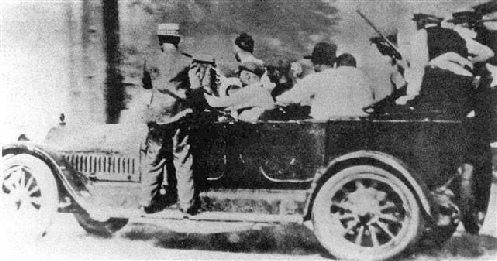
The number of photos of this event are actually amazing, given the chaotic nature of what was going on. Did the person who shot this candid photo of white Tulsans above just happen to have a Brownie camera in his own nearby car??
All of the chatter reported above by eye-
And driving innocent people out of their homes, burning those homes to the ground, killing the occasional innocent bystander in cold blood? No biggie. It’s not like they are “humans” or somethin’. As Huckleberry Finn and Aunt Sally discussed in Mark Twain’s Finn novel, when Huck felt it necessary to come up with a lie for why he was late arriving by steamboat:
“We blowed out a cylinder head.”
“Good gracious! Anybody hurt?”
“No’m. Killed a nigger.”
“Well, it’s lucky; because sometimes people do get hurt.”
I know that many people are very concerned these days that too many Americans don’t consider unborn infants to be human beings. And I too am incredibly distressed by that fact. Abortion is a horrible thing. But I think many such folks never stop to consider that for most of the time since 1776 a significant proportion of the US population has not considered another significant proportion of the US population AFTER birth as truly human. This reality was brought home, for instance, in news photos such as the one below, from the 1968 Memphis Sanitation Workers strike led by Martin Luther King at the height of the Civil Rights movement.
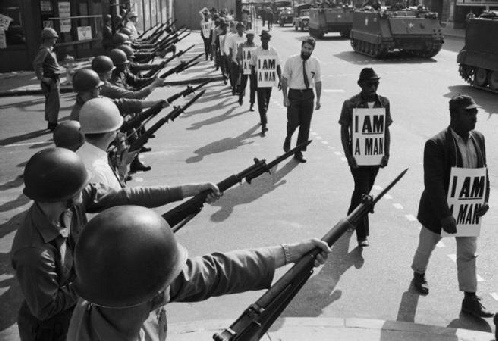
Is it possible that this hasn’t really changed as much over the intervening years as we might think or hope … down at the “heart” level?